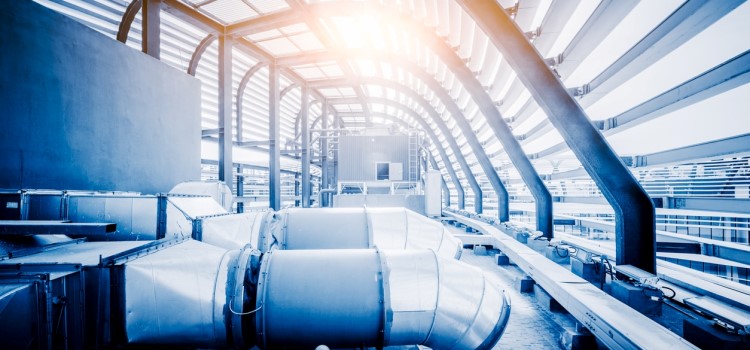Potential Technologies Shaping the Indoor Air Quality with Air Handling Units
Introduction
In the field of modern building infrastructure, the importance of maintaining optimal indoor air quality (IAQ) cannot be overstated. As concerns over health, comfort, and productivity continue to drive demand for efficient heating, ventilation, and air conditioning (HVAC) systems, the role of air handling units (AHUs) has become crucial in achieving superior IAQ standards. The integration of advanced technologies, such as variable-speed drives, heat recovery systems, and advanced control systems, characterizes the evolution of AHUs. These technologies enhance energy efficiency and air quality. Additionally, AHUs are equipped with filtration capabilities, humidification solutions, and thermal wheels or cross-plate heat exchangers. These factors further improve their performance.
As AHUs continue to evolve, they play a pivotal role in shaping the future of indoor environments. Their ability to consume less energy while effectively conditioning and distributing fresh air throughout buildings is contributing to the growth of the AHU market and the overall sustainability of indoor spaces.
At its core, an air handling unit (AHU) is the workhorse of any HVAC system, responsible for regulating and conditioning the air that circulates within a building. AHUs perform many functions, including air filtration, heating, cooling, humidification, dehumidification, and ventilation. AHUs play a critical role in maintaining indoor comfort and air quality by drawing in outside air, conditioning it to the desired temperature and humidity levels, and distributing it throughout a building via ductwork.
Emerging Technologies in AHUs
The landscape of AHU technologies is rapidly evolving, driven by advancements in energy efficiency, sustainability, and smart building automation. Some of the notable emerging technologies in AHUs include:
Smart HVAC Controls: The integration of Internet of Things (IoT) and artificial intelligence (AI) technologies equips AHUs with smart control systems, allowing real-time monitoring, predictive maintenance, and energy optimization. These systems can adjust operation parameters based on occupancy, outdoor conditions, and indoor air quality. This, in turn, ensures optimal performance while minimizing energy consumption. In 2022, Delta, a company based on power and thermal management solutions, introduced an IoT-based energy-saving solution for smart cities and HVAC infrastructure (including AHU) at AHR Expo 2022 in Las Vegas. It is designed to feature the O3 Edge system and a range of IoT-enabled products. The company aims to enhance building efficiency and safety while demonstrating its commitment to sustainability and innovation.
Energy Recovery Ventilation (ERV) Systems: ERV systems capture and reuse energy from exhaust air to pre-condition incoming fresh air. This, in turn, improves energy efficiency and IAQ. By recovering heat or coolness from exhaust air, ERVs help reduce the workload on heating and cooling systems, resulting in significant energy savings. For instance, Air Change offers a wide range of Energy Recovery Ventilators (ERV) to improve indoor air quality and reduce the peak outdoor air load on the air conditioning system. It achieves such improvement by pre-conditioning outdoor air through its patented total enthalpy air-to-air plate heat exchanger. These units can produce significant seasonal energy savings with integrated cooling and heating coil options, economy cycle mode, and return air bypass mode.
Advanced Filtration Technologies: High-efficiency particulate air (HEPA) filters, ultraviolet germicidal irradiation (UVGI) systems, and other advanced filtration technologies are becoming increasingly common in AHUs. These systems remove airborne contaminants, allergens, and pathogens, ensuring cleaner and healthier indoor air. For example, Systemair partnered with Deltrianto to introduce a new line of Eurovent-certified virucidal filters for AHUs. These DELTRI+ filters utilize advanced plasma technology to neutralize or destroy 99% of viruses, including SARS-CoV-2, as confirmed by testing from reputable institutions.
Smart Sensors and Controls: AHUs equipped with smart sensors and advanced control systems enable real-time monitoring and adjustment of airflow, temperature, and humidity. This, in turn, optimizes energy efficiency and indoor air quality. Recently, ABB introduced the FusionAir Smart Sensor. It is a touch-free room sensor that monitors indoor air quality (IAQ), detects pollutants such as carbon dioxide (CO?) and volatile organic compounds (VOCs), and promotes safety and comfort. Indoor air pollution surpassing outdoor levels safeguards occupants' well-being, aligning with ABB's commitment to shaping future trends in electrification and delivering exceptional experiences across industries.
Energy-Efficient Components: The integration of energy-efficient components such as high-efficiency motors, fans, blowers, and heat exchangers helps reduce energy consumption and operating costs. By maximizing energy efficiency, AHUs contribute to sustainability goals and environmental stewardship. For instance, Johnson Controls launched a redesigned line of high-efficiency air handlers. It leads to 10% less energy consumption with a next-gen blower, fully insulated cabinet, and balanced assembly for quiet comfort. It is designed for space-constrained areas and comes in fixed-speed and variable-speed models. These features ensure lasting performance and energy savings.
Conclusion
The evolution of AHUs represents a significant advancement in modern building infrastructure, particularly in managing IAQ. With a focus on energy efficiency, sustainability, and enhanced performance, AHUs have become indispensable components of HVAC systems, driving the pursuit of superior IAQ standards. The integration of advanced technologies such as smart HVAC controls, ERV systems, advanced filtration technologies, smart sensors, and energy-efficient components revolutionized the capabilities of AHUs. This, in turn, optimizes energy consumption and ensures cleaner and healthier indoor air environments.
AHUs are not just meeting current demands but also shaping the future of indoor environments by continuously evolving and adapting to emerging challenges and opportunities. This, in turn, contributes to the growth of the AHU market and fosters overall sustainability in indoor spaces. As we prioritize health, comfort, and productivity in indoor environments, AHUs are crucial assets, providing the foundation for creating spaces where occupants can thrive. Moreover, they pave the way for a future where indoor environments are comfortable, productive, sustainable, and conducive to well-being.
About the Author
 Shyam Gupta is a passionate and highly enthusiastic researcher with over four years of experience. He is dedicated to assisting clients in overcoming challenging business obstacles by providing actionable insights through exhaustive research. Shyam has a keen interest in various industries, including Building Materials, Heavy Machinery, and Commercial Building Construction, and he consistently endeavors to deliver valuable perspectives in these areas. In addition to his research work, Shyam enjoys sharing his thoughts and ideas through articles and blogs. During his leisure time, he finds solace in the world of literature and art, often engrossed in reading and expressing his creativity through painting. The author can be reached at shyam.gupta@nextmsc.com
Shyam Gupta is a passionate and highly enthusiastic researcher with over four years of experience. He is dedicated to assisting clients in overcoming challenging business obstacles by providing actionable insights through exhaustive research. Shyam has a keen interest in various industries, including Building Materials, Heavy Machinery, and Commercial Building Construction, and he consistently endeavors to deliver valuable perspectives in these areas. In addition to his research work, Shyam enjoys sharing his thoughts and ideas through articles and blogs. During his leisure time, he finds solace in the world of literature and art, often engrossed in reading and expressing his creativity through painting. The author can be reached at shyam.gupta@nextmsc.com


Leave a Reply